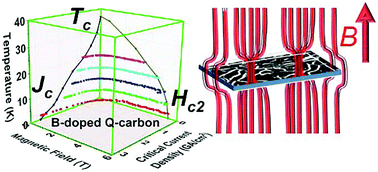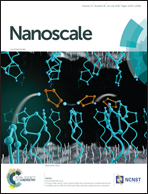Magnetic relaxation and three-dimensional critical fluctuations in B-doped Q-carbon – a high-temperature superconductor†
Abstract
Dimensional fluctuations and magnetic relaxations in high-temperature superconductors are key considerations for practical applications in high-speed electronic devices. We report the creep of trapped magnetic flux and three-dimensional critical fluctuations near the superconducting transition temperature (Tc = 36 K) in B-doped amorphous Q-carbon. The superconducting phase in B-doped Q-carbon is formed by nanosecond pulsed laser melting in a super undercooled state followed by subsequent quenching. Time-dependent magnetic moment measurements in the B-doped Q-carbon follow the Anderson–Kim logarithmic decay model with the calculated value of pinning potential to be 0.75 eV at 1 T near Tc. There is also strong evidence of three-dimensional (3D) critical fluctuations near Tc in B-doped Q-carbon. The crossover from 2D to 3D critical fluctuations is seen at T/Tc = 1.01 as compared to T/Tc = 1.11 in conventional Bardeen–Cooper–Schrieffer (BCS) high-temperature superconductors. These critical fluctuations indicate moderate to strong electron–phonon coupling in B-doped Q-carbon. The isomagnetic temperature-dependent resistivity measurements reveal a broadening of superconducting transition width with increasing magnetic field. The upper critical field (Hc2(0)) is calculated to be 5.6 T using the power law. Finally, the superconducting region is determined in B-doped Q-carbon, as the three vertices of the superconducting region are calculated as Tc = 36.0 K, Jc = 2.9 × 109 A cm−2 and Hc2 = 5.6 T. The temperature-dependent magnetic moment and resistivity measurements also validate B-doped Q-carbon as a BCS type-II superconductor. B concentration in Q-carbon can be increased up to 50 at% by a nanosecond laser melting and quenching technique, thus providing an ideal platform for near room-temperature superconductivity.



 Please wait while we load your content...
Please wait while we load your content...